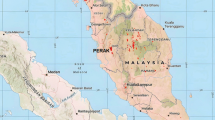Abstract
In order to investigate the extent of vegetation change during the Pleistocene Period, a study of three high elevation southern Appalachian bogs was undertaken. Three North Carolina sites were chosen that were suitable for pollen and paleoecological analysis: Flat Laurel Gap bog near Pisgah Mountain south of Asheville (elevation 1500 m), Boone Fork bog near Blowing Rock (elevation 1024 m), and Long Hope Valley bog north of Boone (elevation 1450 m).
Existing vegetation was sampled by transects of 10×10 m plot relevés that crossed a section of forest and open bog areas. While each site included a characteristic southern Appalachian bog, each differed: Flat Laurel Gap is predominately a heath community with interfingerings of open grassy glades which grade into a mixture of northern hardwoods and spruce; Boone Fork bog is a disturbed mixture of northern hardwoods which grades into a mixture of scattered shrubs and open glades predominated by Sphagnum; and Long Hope Menyanthes bog is an open herbaceous and grassy glade with scattered shrubs which grades abruptly into northern hardwoods and old-growth spruce. As might be expected, the more northern Long Hope Valley site had more northern taxa, such as Menyanthes trifoliata, Lonicera canadensis, and Vaccinium macrocarpon. The southern site also had a few boreal taxa such as Eriophorum virginicum.
Perhaps the best interpretation for these long-established southern Appalachian bogs is that they have provided continuously suitable habitats for relict northern species since the peak of the glacial ice advance 18,000 years ago.
Similar content being viewed by others
References
Cowardin, L. M., Carter, V., Golet, F. C. and LaRoe, E. T., 1979, Classification of wetlands and deepwater habitats of the United States. U. S. Fish and Wildlife Service, Office of Biological Services, Washington, DC. 136 p.
Delcourt, H. R., 1985, ‘Holocene vegetational changes in the southern Appalachian mountains, U.S.A.,’ Ecol. Mediterr. 11, 9–15.
Delcourt, P. A., 1985, ‘The influence of Late-Quaternary climatic and vegetational change on paleohydrology in unglaciated eastern North America’, Ecol, Mediterr. 11, 17–26.
Delcourt, H. R. and Delcourt, P. A., 1975., ‘The Blufflands: Pleistocene pathway into the Tunica hills,’ Am. Mid. Nat. 94, 385–400.
Delcourt, H. R. and Delcourt, P. A., 1985, ‘Quaternary palynology and vegetational history of the southeastern United States,’ in Bryant, V. M., Jr., and Holloway, R. G. (eds), Pollen records of late-quaternary North American sediments. American Assoc. of Stratigraphic Palynologists Foundation, Calgary, Alberta, Can., pp. 1–37.
Gaddy, L. L., 1981., ‘The bogs of the southwestern mountains of North Carolina,’ Report to the North Carolina Natural Heritage Program, Department of Natural Resources and Community Development, Raleigh. 6 p + appendix.
Gibson, J. R., 1982, ‘Alder Run Bog, Tucker County, West Virginia: its history and vegetation,” in Clarkson, R. B. et al. (eds.), Symposium on wetlands of the unglaciated Appalachian region. Univ. of West Virginia, Morgantown, pp. 101–105.
Horton, J. H. and Hotaling, L. G., 1981, ‘Floristics of selected heath communities along the southern section of the Blue Ridge Parkway,’ U. S. Department of Interior, National Park Service, NPS-SER Research/Resources Management Report No. 45, Atlanta, GA, 36 p.
Moore, T., 1972, The phytoecology of Boone Fork sphagnum bog, M. S. Thesis, Appalachian State University, Boone, North Carolina, 45 p.
Mueller-Dumbois, D. and Ellenburg, H., 1974, Aims and methods of vegetation ecology, John Wiley & Sons, NY, 547 p.
Radford, A. E., Ahles, H. E., and C. R. Bell, 1968, Manual of the vascular flora of the Carolinas, UNC Press, Chapel Hill, NC, 1180p.
Richardson, C. J. and Gibbons, J. W., 1994, ‘Pocosins, Carolina bays, and mountain bogs,’ p. 257–310, in Martin, W. H., Boyce, S. G. and Echternacht, A. C., Biodiversity of the southeastern United States: lowland terrestrial communities, John Wiley & Sons, Inc., New York.
Rigg, G. B. and Strausbaugh, P. D., 1949, ‘Some states in the development of sphagnum bogs in West Virginia,’ Castanea 14, 129–148.
Schafale, M. P. and Weakley, A. S., 1990, Classification of the natural communities of North Carolina (Third approximation), NC Department of Environment, Health, and Natural Resources, Natural Heritage Program, Raleigh, NC. 325 p.
Shafer, D. S., 1984, Late-Quaternary paleoecology, paleoclimatology, and geomorphology of Flat Laurel Gap, a high-elevation heath bog in the Blue Ridge Mountains of western North Carolina, M. S. Thesis, The University of Tennessee, Knoxville, 148 p.
Shafer, D. S., 1986, ‘Flat Laurel Gap bog, Pisgah Ridge, North Carolina: late Holocene development of a high-elevation heath bald,’ Castanea 51, 1–9.
Shafer, D. S., 1988, ‘Late Quaternary landscape evolution at Flat Laurel Gap, Blue Ridge Mountains, North Carolina,’ Quat. Res. 30, 7–11.
Author information
Authors and Affiliations
Rights and permissions
About this article
Cite this article
Pittillo, J.D. Vegetation of three high elevation Southern Appalachian bogs and implications of their vegetational history. Water Air Soil Pollut 77, 333–348 (1994). https://doi.org/10.1007/BF00478426
Issue Date:
DOI: https://doi.org/10.1007/BF00478426




